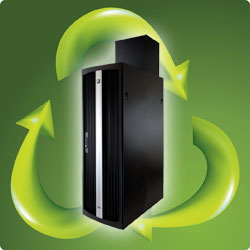It is the day after Thanksgiving and it is time to get creative with the leftovers, but really, how many ways can you serve turkey? You may be surprised what people do to make sure they get the most out of their Thanksgiving meal – like my turkey quesadillas for example.
It seems, however, that the American family isn’t the only one trying to get the biggest bang for their buck. Earlier this week I was very entertained when I read about the creative solutions being proposed to battle power consumption in the data center. How about putting data centers on decommissioned ships in order to get rid of waste heat into the ocean or reusing hot water from cooling systems to fill the town swimming pool? One large health care center is looking at reusing hot water expelled by its cooling system to do its laundry, according to Subodh Bapat, VP for Energy Efficiency at Sun Microsystems in an article published at Infoworld.com.
Are such drastic measures necessary? Bapat explained that as each generation of microprocessors become more powerful, there is a 14 percent increase in the power consumed by each server. At the same time, energy prices in the United States have increased by about 12 percent on average for the past three years and are expected to keep climbing.
 Here at CPI we have been preaching for quite a few years about how air flow management is the key to simple, effective data center cooling that reduces energy consumption and saves money. Further along in the article Bill Tschudi of the Lawrence Berkeley National Laboratory was quoted as saying, “One of the most effective (solutions) is better air-flow management so that cold air pumped in to cool equipment doesn’t mix with hot exhaust air coming out.” This concept is what we call CPI Passive Cooling® Solutions. He goes on to explain that alternating hot and cold aisles is only partially effective because the air mixes in the spaces above the aisles. With CPI Passive Cooling hot air/cold air isolation is so complete, there is no need for hot aisle/cold aisles. The temperature in the room stays at a constant temperature as the cool air is drawn into the cabinet, through the servers and up the back of the cabinet into a duct that expels the hot air into the drop ceiling where it is returned to the cooling unit. CPI’s F-Series TeraFrame Cabinet, a ducted exhaust cabinet, was designed for, and is very efficient at accomplishing this.
Here at CPI we have been preaching for quite a few years about how air flow management is the key to simple, effective data center cooling that reduces energy consumption and saves money. Further along in the article Bill Tschudi of the Lawrence Berkeley National Laboratory was quoted as saying, “One of the most effective (solutions) is better air-flow management so that cold air pumped in to cool equipment doesn’t mix with hot exhaust air coming out.” This concept is what we call CPI Passive Cooling® Solutions. He goes on to explain that alternating hot and cold aisles is only partially effective because the air mixes in the spaces above the aisles. With CPI Passive Cooling hot air/cold air isolation is so complete, there is no need for hot aisle/cold aisles. The temperature in the room stays at a constant temperature as the cool air is drawn into the cabinet, through the servers and up the back of the cabinet into a duct that expels the hot air into the drop ceiling where it is returned to the cooling unit. CPI’s F-Series TeraFrame Cabinet, a ducted exhaust cabinet, was designed for, and is very efficient at accomplishing this.
The Planet, a leading provider of On Demand IT Infrastructure solutions, just this week announced the upgrade of one of its data centers located in Dallas. The Planet is using CPI ducted exhaust cabinets in the new phase, taking steps beyond traditional hot aisle/cold aisle setups to completely isolate the hot and cold air in the data center. The company estimates the data center’s coefficient of efficiency will be approximately 1.5, which is below the 1.6 ideal ranking.
Jeff Lowenberg, Vice President of Facilities at The Planet noted, “…operating our data centers at peak performance is important to both our company and our customers, especially as we prepare for our future.
Preparing for the future now is wise advice. A recent report by the DMW Group stated that 70 percent of businesses in the United Kingdom are concerned about future power shortages but few are taking steps to prepare despite possible power shortages in the near future. Fortunately, the energy issue is taking a front seat in today’s data center discussions. If you would like to find out more about the read CPI’s thermal solutions, read the white paper, The Biggest Opportunity for Data Center Energy Savings. If you have a comment, please select the comment link below. Kim Ream, Sr. eCommerce Specialist